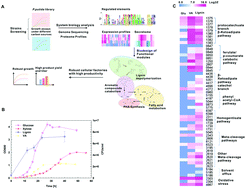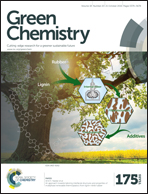Systems biology-guided biodesign of consolidated lignin conversion†
Abstract
Lignin is the second most abundant biopolymer on the earth, yet its utilization for fungible products is complicated by its recalcitrant nature and remains a major challenge for sustainable lignocellulosic biorefineries. In this study, we used a systems biology approach to reveal the carbon utilization pattern and lignin degradation mechanisms in a unique lignin-utilizing Pseudomonas putida strain (A514). The mechanistic study further guided the design of three functional modules to enable a consolidated lignin bioconversion route. First, P. putida A514 mobilized a dye peroxidase-based enzymatic system for lignin depolymerization. This system could be enhanced by overexpressing a secreted multifunctional dye peroxidase to promote a two-fold enhancement of cell growth on insoluble kraft lignin. Second, A514 employed a variety of peripheral and central catabolism pathways to metabolize aromatic compounds, which can be optimized by overexpressing key enzymes. Third, the β-oxidation of fatty acid was up-regulated, whereas fatty acid synthesis was down-regulated when A514 was grown on lignin and vanillic acid. Therefore, the functional module for polyhydroxyalkanoate (PHA) production was designed to rechannel β-oxidation products. As a result, PHA content reached 73% per cell dry weight (CDW). Further integrating the three functional modules enhanced the production of PHA from kraft lignin and biorefinery waste. Thus, this study elucidated lignin conversion mechanisms in bacteria with potential industrial implications and laid out the concept for engineering a consolidated lignin conversion route.


 Please wait while we load your content...
Please wait while we load your content...